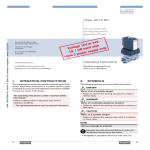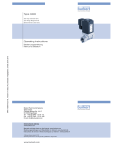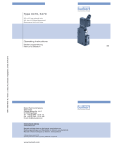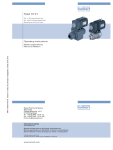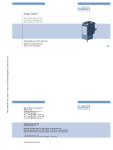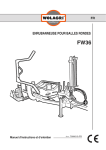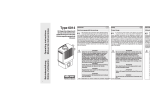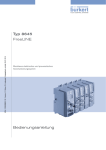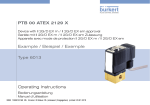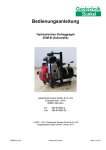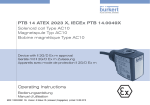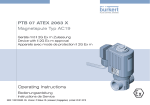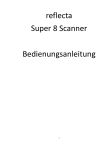Download Type 6213 EV, 6281 EV
Transcript
Type 6213 EV, 6281 EV 2/2-way solenoid valve 2/2-Wege-Magnetventil Électrovanne 2/2 voies Operating Instructions Bedienungsanleitung Manuel d‘utilisation Bürkert Fluid Control Systems Sales Center Christian-Bürkert-Str. 13-17 D-74653 Ingelfingen Tel. + 49 (0) 7940 - 10 91 111 Fax + 49 (0) 7940 - 10 91 448 E-mail: [email protected] International address www.burkert.com Manuals and data sheets on the Internet: www.burkert.com Bedienungsanleitungen und Datenblätter im Internet: www.buerkert.de Instructions de service et fiches techniques sur Internet : www.buerkert.fr © Bürkert Werke GmbH, 2013 Operating Instructions 1309/03_EU-ML_00805875 / Original DE www.burkert.com Type 6213 EV / 6281 EV 1 Operating Instructions The operating instructions contain important information. ▶▶ Read the operating instructions carefully and follow the safety instructions in particular, and also observe the operating conditions. ▶▶ Operating instructions must be available to each user. ▶▶ The liability and warranty for the product / device are void if the operating instructions are not followed. 1.1 Symbols ▶▶ Designates an instruction to prevent risks. →→designates a procedure which you must carry out. Warning of injuries: Danger! Imminent danger! Serious or fatal injuries. Warning! Potential danger! Serious or fatal injuries. Caution! Danger! Minor or moderately severe injuries. Warns of damage to property: Note! Intended use Incorrect use of the solenoid valve can be dangerous to people, nearby equipment and the environment. ▶▶ The device type 6213 EV / 6281 EV is designed to control, shut off and meter neutral media up to a viscosity of 21 mm2/s. ▶▶ Provided the cable plug is connected and installed correctly, e.g. Bürkert Type 2508, the device satisfies protection class IP65 in accordance with DIN EN 60529 / IEC 60529. ▶▶ Use according to the permitted data, operating conditions and conditions of use specified in the contract documents and operating instructions. ▶▶ Correct transportation, correct storage and installation and careful use and maintenance are essential for reliable and problem-free operation. ▶▶ Use the device only as intended. 2.1 Restrictions If exporting the device, observe any existing restrictions. 2.2 Definition of term In these operating instructions, the term “device” always refers to the Type 6213 EV / 6281 EV. english 2 3 2 Basic safety instructions These safety instructions do not make allowance for any •contingencies and events which may arise during the installation, operation and maintenance of the devices. •local safety regulations - the operator is responsible for observing these regulations, also with reference to the installation personnel. Danger - high pressure! ▶▶ Before loosening the pipes and valves, turn off the pressure and vent the pipes. Risk of electric shock! ▶▶ Before reaching into the device or the equipment, switch off the power supply and secure to prevent reactivation! ▶▶ Observe applicable accident prevention and safety regulations for electrical equipment! Risk of burns/risk of fire if used for a prolonged switch-on time through hot device surface! ▶▶ Keep the device away from highly flammable substances and media and do not touch with bare hands. 3 Risk of injury due to malfunction of valves with alternating current (AC). Sticking core causes coil to overheat, resulting in a malfunction. ▶▶ Monitor process to ensure function is in perfect working order. Risk of short-circuit/escape of media through leaking screw joints. ▶▶ Ensure seals are seated correctly! ▶▶ Carefully screw valve and connection lines together! To prevent injury, ensure that: ▶▶ Do not make any external modifications to the device bodies. Ensure that the system cannot be activated unintentionally. ▶▶ Installation and repair work may be carried out by authorized technicians only and with the appropriate tools. ▶▶ After an interruption in the power supply or fluidic supply, ensure that the process is restarted in a defined or controlled manner. ▶▶ Do not put any loads on the body. ▶▶ The general rules of technology apply to application planning and operation of the device. english 3.1 Warranty 4 The warranty is only valid if the device is used as intended in accordance with the specified application conditions. 4.1 Operating conditions 3.2 Information on the internet The operating instructions and data sheets for type 6213 EV / 6281 EV can be found on the internet at: www.buerkert.com Type 6213 EV / 6281 EV Technical data The following values are indicated on the type label: ▶▶ Voltage (Tolerance ± 10 %) / Current type ▶▶ Coil power consumption (active power in W - at operating temperature) ▶▶ Pressure range ▶▶ Body material: Brass (MS), Stainless steel (VA) ▶▶ Seal material: FKM, EPDM, NBR Operating principle: A 2/2-way valve, normally closed A (NC) P B (NO) 2/2-way valve, normally opened Protection class:IP65 with accordance with DIN EN 60529 / IEC 60529 with cable plug, e. g. Bürkert Type 2508 4 english Type 6213 EV / 6281 EV 4.2 Application conditions Permitted media depending on seal material: Ambient temperature:max. +55 °C Seal material FKM Operating duration: Unless otherwise indicated on the type label, the solenoid system is suitable for continuous operation Important information for functional reliability during continuous operation! If standstill for a long period at least 1-2 activations per day are recommended. Service life: High switching frequency and high pressures reduce the service life EPDM NBR 2) 1) Seal material Medium temperature FKM FKM EPDM EPDM NBR 0 ... +90 °C 0 ... +120 °C -30 ... +90 °C -30 ... +100 °C -10 ... +80 °C Marking PA and EP under electric connection Gaseous media at low differential pressures (e.g. compressed air and vacuum) can also be actuated in consideration (or due to restriction) of a lower tightness. We recommend prior clarification with our sales office regarding the possible application Permitted medium temperature depending on coil and seal material: Coil body PA/EP1) Polyamide PA Epoxy EP (NA38) Polyamide PA Epoxy EP (NA38) Polyamide PA Permitted media 2) Per-solutions, hot oils without additives, diesel and heating oil without additives, detergent solution Oil and grease-free liquids, cold and warm water Cold and warm water 4.3 Conformity In accordance with the EC Declaration of conformity, the solenoid valve Type 6213 EV / 6281 EV is compliant with the EC Directives. 4.4 Standards The applied standards, which verify conformity with the EC Directives, can be found on the EC Type Examination Certificate and / or the EC Declaration of Conformity. english 5 5 4.5 Type label Orifice Seal material 5.1 Safety instructions Operating principle Danger! Type Body material Made in Germany Installation 6213EV A 10 EPDM MS G3/8 P N0 - 10bar 230V 50Hz 8W 00221649 W14 LU Identification number Manufacturer code Voltage, Frequency, Power consumption Connection thread, Nominal pressure Risk of injury from high pressure in the equipment! ▶▶ Before loosening the lines and valves, turn off the pressure and vent the lines. Risk of injury due to electrical shock! ▶▶ Before reaching into the system, switch off the power supply and secure to prevent reactivation! ▶▶ Observe applicable accident prevention and safety regulations for electrical equipment! Warning! Risk of injury from improper installation! ▶▶ Installation may be carried out by authorized technicians only and with the appropriate tools! Risk of injury from unintentional activation of the system and an uncontrolled restart! ▶▶ Secure system from unintentional activation. ▶▶ Following installation, ensure a controlled restart. english 6 5.2 Before installation 5.4 Manual emergency actuation Installation position: any, actuator preferably upwards. To control the valve manually, the hand lever under the coil must be turned into the vertical position. Procedure: →→Check pipelines for dirt and clean. →→Install a dirt filter before the valve inlet (≤ 500 µm). 5.3 Installation Note! Note! Caution! ▶▶ Do not overturn hand lever! ▶▶ When the hand lever is actuated, the valve can no longer be switched electrically. Caution risk of breakage! •Do not use the coil as a lifting arm. →→Hold the device with a open-end wrench on the body and screw into the pipeline. Hand lever →→Observe direction of flow: Opened position The arrow on the body indicates the direction of flow. Closed position 7 english Type 6213 EV / 6281 EV 5.5 Electrical connection of the cable plug Warning! Note the voltage and current type as specified on the type label. Seal Risk of injury due to electrical shock! ▶▶ Before reaching into the system, switch off the power supply and secure to prevent reactivation! ▶▶ Observe applicable accident prevention and safety regulations for electrical equipment! If the protective conductor contact between the coil and body is missing, there is danger of electrical shock! ▶▶ Always connect protective conductor. ▶▶ Check electrical continuity between coil and body. Procedure: →→Tighten cable plug (for permitted types see data sheet), observing max. torque 1 Nm. →→Check that seal is fitted correctly. →→Connect protective conductor and check electrical continuity between coil and body. Authorized cable plug e.g. Type 2508 or other suitable cable plug in accordance with DIN EN 175301-803 Form A Pulse version (optional, Code CF 16): •Valve opens when current pulse min. 50 ms: – on Pin 1, + on Pin 2 •Valve closes when current pulse min. 50 ms: + on Pin 1, – on Pin 2 1 Maintenance, Troubleshooting 6.1 Safety instructions Warning! Risk of injury from improper maintenance! ▶▶ Maintenance may be carried out by authorized technicians only and with the appropriate tools! Risk of injury from unintentional activation of the system and an uncontrolled restart! ▶▶ Secure system from unintentional activation. ▶▶ Following maintenance, ensure a controlled restart. 6.2 Installation of the coil Escaping medium! When a sticking nut is loosened, medium may escape. ▶▶ Do not tighten sticking nut any further. Overheating, risk of fire! Connection of the coil without pre-assembled valve will result in overheating and destroy the coil. ▶▶ Connect the coil with pre-assembled valve only. Danger due to electrical shock if coil incorrectly installed! ▶▶ During installation ensure that the coil is situated firmly on the body cover so that the protective conductor connection of the coil is connected to the valve body. Procedure: →→Connect coil body to the core guide pipe. →→Screw on coil with nut. Observe torque. Warning! Electric shock! ▶▶ Before reaching into the system, switch off the power supply and secure to prevent reactivation! If the protective conductor contact between the coil and body is missing, there is danger of electrical shock! ▶▶ Check protective conductor contact after installing the coil. Note! Device will be damaged if the wrong tools are used! Always use a wrench to tighten nut. If other tools are used (e.g. pliers), the device may be damaged. →→Check protective conductor. english 9 6.3 Malfunctions Nut If malfunctions occur, check whether: Core guide pipe O-ring Observe torque for fastening nut! (See table) Locking pin →→the device has been installed according to the instructions, →→the electrical and fluid connections are correct, →→the device is not damaged, →→all screws have been tightened, →→the voltage and pressure have been switched on, →→the pipelines are clean. Valve does not switch Possible cause: •Short circuit or coil interrupted, •Core or core area dirty. Torque for fastening nut: Coil type AC10 AC19 •Medium pressure outside the permitted pressure range. Coil width 32 mm resp. 40 mm 42 mm Torque [Nm] 5 Nm 10 Nm Valve does not close Possible cause: •Internal space of the valve is dirty. •Small control bore in the diaphragm blocked. •Valve opened by manual control. 10 2 english 8 6 max. 1 Nm english Type 6213 EV / 6281 EV 7 Spare parts 7.2 Overview of replacement part sets Caution! Risk of injury and/or damage by the use of incorrect parts! Incorrect accessories and unsuitable spare parts may cause injuries and damage the device and the surrounding area. ▶▶ Use only original accessories and original spare parts from Bürkert. 6281 EV Coil set SET 1 Plunger tube set SET 7 7.1 Ordering spare parts Replacement part sets When ordering replacement part sets, quote the sets SET 1, SET 3 or SET 7 and the identification number of the device. Wearingparts set SET 3 english 11 8 Transport, Storage, Disposal Note! Transport damages! Inadequately protected equipment may be damaged during transport. •During transportation protect the device against wet and dirt in shock-resistant packaging. •Avoid exceeding or dropping below the allowable storage temperature. Incorrect storage may damage the device. •Store the device in a dry and dust-free location! •Storage temperature: - 40 °C ... +80 °C. Damage to the environment caused by device components contaminated with media. •Observe applicable regulations on disposal and the environment. →→Dispose of the device and packaging in an environmentally friendly manner. 12 english 6213 EV Coil set SET 1 Wearingparts set SET 3 Type 6213 EV, 6281 EV 2/2-way solenoid valve 2/2-Wege-Magnetventil Électrovanne 2/2 voies Operating Instructions Bedienungsanleitung Manuel d‘utilisation Bürkert Fluid Control Systems Sales Center Christian-Bürkert-Str. 13-17 D-74653 Ingelfingen Tel. + 49 (0) 7940 - 10 91 111 Fax + 49 (0) 7940 - 10 91 448 E-mail: [email protected] International address www.burkert.com Manuals and data sheets on the Internet: www.burkert.com Bedienungsanleitungen und Datenblätter im Internet: www.buerkert.de Instructions de service et fiches techniques sur Internet : www.buerkert.fr © Bürkert Werke GmbH, 2013 Operating Instructions 1309/03_EU-ML_00805875 / Original DE www.burkert.com Typ 6213 EV / 6281 EV 1 Die Bedienungsanleitung Die Bedienungsanleitung enthält wichtige Informationen. ▶▶ Bedienungsanleitung sorgfältig lesen und Hinweise zur Sicherheit beachten. ▶▶ Bedienungsanleitung muss jedem Benutzer zur Verfügung stehen. ▶▶ Haftung und Gewährleistung für das Produkt / Gerät entfällt, wenn die Anweisungen der Bedienungsanleitung nicht beachtet werden. 1.1 Darstellungsmittel ▶▶ markiert eine Anweisung zur Gefahrenvermeidung. →→markiert einen Arbeitsschritt, den Sie ausführen müssen. Warnung vor Verletzungen: Gefahr! Unmittelbare Gefahr! Schwere oder tödliche Verletzungen. Warnung! Mögliche Gefahr! Schwere oder tödliche Verletzungen. Vorsicht! Gefahr! Leichte oder mittelschwere Verletzungen. Warnung vor Sachschäden: Hinweis! 2 BestimmungsgemäSSe Verwendung Bei nicht bestimmungsgemäßem Einsatz des Magnetventils Typ 6213 EV / 6281 EV können Gefahren für Personen, Anlagen in der Umgebung und die Umwelt entstehen. ▶▶ Das Gerät ist zum Steuern, Absperren und Dosieren von neutralen Medien bis zu einer Viskosität von 21 mm2/s konzipiert. ▶▶ Mit einer sachgemäß angeschlossenen und montierten Gerätesteckdose, z. B. Bürkert Typ 2508 erfüllt das Gerät die Schutzart IP65 nach DIN EN 60529 / IEC 60529. ▶▶ Für den Einsatz die in den Vertragsdokumenten und der Bedienungsanleitung spezifizierten zulässigen Daten, Betriebs- und Einsatzbedingungen beachten. ▶▶ Voraussetzungen für den sicheren und einwandfreien Betrieb sind sachgemäßer Transport, sachgemäße Lagerung und Installation sowie sorgfältige Bedienung und Instandhaltung. ▶▶ Das Gerät nur bestimmungsgemäß einsetzen. 2.1 Beschränkungen Beachten Sie bei Ausfuhr des Geräts bestehende Beschränkungen. 2.2 Begriffsdefinition Der verwendete Begriff „Gerät“ steht immer für Typ 6213 EV / 6281 EV. deutsch 3 Grundlegende Sicherheitshinweise Diese Sicherheitshinweise berücksichtigen keine: •Zufälligkeiten und Ereignisse, die bei Montage, Betrieb und Wartung der Geräte auftreten können. •Ortsbezogenen Sicherheitsbestimmungen, für deren Einhaltung, auch in Bezug auf das Montagepersonal, der Betreiber verantwortlich ist. Gefahr durch hohen Druck! ▶▶ Vor dem Lösen von Leitungen und Ventilen den Druck abschalten und Leitungen entlüften. Gefahr durch elektrische Spannung! ▶▶ Vor Eingriffen in das Gerät oder die Anlage Spannung abschalten und vor Wiedereinschalten sichern. ▶▶ Die geltenden Unfallverhütungs- und Sicherheitsbestimmungen für elektrische Geräte beachten. Verbrennungsgefahr/Brandgefahr bei Dauerbetrieb durch heiße Geräteoberfläche! ▶▶ Das Gerät von leicht brennbaren Stoffen und Medien fernhalten und nicht mit bloßen Händen berühren. 13 Verletzungsgefahr durch Funktionsausfall bei Ventilen mit Wechselspannung (AC)! Festsitzender Kern bewirkt Spulenüberhitzung, die zu Funktionsausfall führt. ▶▶ Arbeitsprozess auf einwandfreie Funktion überwachen. Kurzschlussgefahr/Austritt von Medium durch undichte Verschraubungen! ▶▶ Auf einwandfreien Sitz der Dichtungen achten. ▶▶ Ventil und Anschlussleitungen sorgfältig verschrauben. Allgemeine Gefahrensituationen. ▶▶ An Typ 6213 EV / 6281 EV keine inneren oder äußeren Veränderungen vornehmen. Anlage/Gerät vor unbeabsichtigter Betätigung sichern. ▶▶ Installations- und Instandhaltungsarbeiten dürfen nur von autorisiertem Fachpersonal mit geeignetem Werkzeug ausgeführt werden. ▶▶ Nach einer Unterbrechung der elektrischen oder fluidischen Versorgung ist ein definierter oder kontrollierter Wiederanlauf des Prozesses zu gewährleisten. ▶▶ Gehäuse nicht mechanisch belasten. ▶▶ Die allgemeinen Regeln der Technik einhalten. deutsch 14 3.1 Gewährleistung 4 Voraussetzung für die Gewährleistung ist der bestimmungsgemäße Gebrauch des Geräts unter Beachtung der spezifizierten Einsatzbedingungen. 4.1 Betriebsbedingungen 3.2 Informationen im Internet Bedienungsanleitungen und Datenblätter zum Typ 6213 EV / 6281 EV finden Sie im Internet unter: www.buerkert.de Typ 6213 EV / 6281 Technische Daten Folgende Werte sind auf dem Typschild angegeben: ▶▶ Spannung (Toleranz ± 10 %) / Stromart ▶▶ Spulenleistung (Wirkleistung in W - betriebswarm) ▶▶ Druckbereich ▶▶ Gehäusewerkstoff: Messing (MS), Edelstahl (VA) ▶▶ Dichtwerkstoff: FKM, EPDM, NBR Wirkungsweise: A 2/2-Wege Ventil, stromlos geschlossen A (NC) P B (NO) 2/2-Wege Ventil, stromlos geöffnet Schutzart:IP65 nach DIN EN 60529 / IEC 60529 mit Gerätesteckdose, z. B. Bürkert Typ 2508 deutsch 15 Typ 6213 EV / 6281 EV 4.2 Einsatzbedingungen Zulässige Medien in Abhängigkeit vom Dichtwerkstoff: Umgebungstemperatur:max. +55 °C Dichtwerkstoff FKM Betriebsdauer:Wenn auf dem Typschild nicht anders angegeben, ist das Magnetsystem für Dauerbetrieb geeignet EPDM Wichtiger Hinweis für die Funktionssicherheit bei Dauerbetrieb! Bei langem Stillstand wird eine Mindestbetätigung von 1-2 Schaltungen pro Tag empfohlen. NBR Gasförmige Medien bei kleinen Differenzdrücken (z. B. Druckluft und Vakuum) können unter Berücksichtigung (oder Einschränkung) einer geringeren Dichtheit ebenfalls geschalten werden. Wir empfehlen eine vorherige Klärung der Einsatzmöglichkeit mit unserer Vertriebsniederlassung 2) Lebensdauer:Hohe Schaltfrequenz und hohe Drücke verringern die Lebensdauer Zulässige Mediumstemperatur in Abhängigkeit von Spule und Dichtwerkstoff: Spulengehäuse PA/EP1) Polyamid PA Epoxid EP (NA38) Polyamid PA Epoxid EP (NA38) Polyamid PA 1) Dichtwerkstoff Mediumstemperatur FKM FKM EPDM EPDM NBR 0 ... +90 °C 0 ... +120 °C -30 ... +90 °C -30 ... +100 °C -10 ... +80 °C Zulässige Medien 2) Per-Lösungen, heiße Öle ohne Additive, Diesel und Heizöl ohne Additive, Waschlauge Öl- und fettfreie Flüssigkeiten, Kalt- und Warmwasser Kalt- und Warmwasser 4.3 Konformität Das Magnetventil, Typ 6213 EV / 6281 EV ist konform zu den EGRichtlinien entsprechend der EG-Konformitätserklärung. 4.4 Normen Die angewandten Normen, mit denen die Konformität mit den EG-Richtlinien nachgewiesen wird, sind in der EG-Baumusterprüfbescheinigung und/oder der EG-Konformitätserklärung nachzulesen. Kennzeichnung PA bzw. EP unter elektrischem Anschluss deutsch 16 5 4.5 Typschild Nennweite 5.1 Sicherheitshinweise Dichtwerkstoff Wirkungsweise Gefahr! Typ Gehäusewerkstoff Made in Germany Montage 6213EV A 10 EPDM MS G3/8 P N0 - 10bar 230V 50Hz 8W 00221649 W14 LU Identnummer Hersteller-Code Verletzungsgefahr durch hohen Druck in der Anlage! ▶▶ Vor dem Lösen von Leitungen oder Ventilen den Druck abschalten und Leitungen entlüften. Verletzungsgefahr durch Stromschlag! ▶▶ Vor Eingriffen in das Gerät oder die Anlage Spannung abschalten und vor Wiedereinschalten sichern! ▶▶ Die geltenden Unfallverhütungs- und Sicherheitsbestimmungen für elektrische Geräte beachten! Warnung! Spannung, Frequenz, Leistung Verletzungsgefahr bei unsachgemäßer Montage! ▶▶ Die Montage darf nur autorisiertes Fachpersonal mit geeignetem Werkzeug durchführen! Verletzungsgefahr durch ungewolltes Einschalten der Anlage und unkontrollierten Wiederanlauf! ▶▶ Anlage vor unbeabsichtigtem Betätigen sichern. ▶▶ Nach der Montage einen kontrollierten Wiederanlauf gewährleisten. Anschlussart, Nenndruck deutsch 17 5.2 Vor dem Einbau 5.4 Handnotbetätigung Einbaulage: beliebig, vorzugsweise Antrieb oben. Zur manuellen Betätigung des Ventils muss der Handhebel unterhalb der Spule in senkrechte Stellung gedreht werden. Vorgehensweise: →→Rohrleitungen von eventuellen Verschmutzungen säubern. →→Vor dem Ventileingang einen Schmutzfilter einbauen (≤ 500 µm). 5.3 Einbau Hinweis! Hinweis! Vorsicht! ▶▶ Handhebel nicht überdrehen! ▶▶ Bei betätigtem Handhebel kann das Ventil elektrisch nicht mehr geschaltet werden. Vorsicht Bruchgefahr! •Spule nicht als Hebelarm benutzen. →→Das Gerät mit einem Gabelschlüssel am Gehäuse festhalten und in die Rohrleitung einschrauben. Handhebel →→Durchflussrichtung beachten: Geöffnete Stellung Der Pfeil auf dem Gehäuse kennzeichnet die Durchflussrichtung. Geschlossene Stellung 18 deutsch Typ 6213 EV / 6281 EV 5.5 Elektrischer Anschluss der Gerätesteckdose Spannung und Stromart laut Typschild beachten. Warnung! Dichtung Verletzungsgefahr durch Stromschlag! ▶▶ Vor Eingriffen in das Gerät oder die Anlage, Spannung abschalten und vor Wiedereinschalten sichern! ▶▶ Die geltenden Unfallverhütungs- und Sicherheitsbestimmungen für elektrische Geräte beachten! Bei nicht angeschlossenem Schutzleiter besteht die Gefahr des Stromschlags! ▶▶ Schutzleiter immer anschließen und elektrischer Durchgang zwischen Spule und Gehäuse prüfen. max. 1 Nm Zugelassene Gerätesteckdose z. B. Typ 2508 oder andere nach DIN ISO 175301-803 Form A Vorgehensweise: →→Gerätesteckdose (zugelassene Typen siehe Datenblatt) fest- schrauben, dabei maximalen Drehmoment 1 Nm beachten. →→Korrekten Sitz der Dichtung überprüfen. →→Schutzleiter anschließen und elektrischer Durchgang zwischen Spule und Gehäuse prüfen. Impulsausführung (optional, Code CF 16): •Ventil öffnet bei Stromimpuls min. 50 ms: - auf Pin 1, + auf Pin 2 •Ventil schließt bei Stromimpuls min. 50 ms: + auf Pin 1, - auf Pin 2 1 2 deutsch 6 Wartung, Fehlerbehebung 6.1 Sicherheitshinweise Warnung! Verletzungsgefahr bei unsachgemäßen Wartungsarbeiten! ▶▶ Die Wartung darf nur autorisiertes Fachpersonal mit geeignetem Werkzeug durchführen! Verletzungsgefahr durch ungewolltes Einschalten der Anlage und unkontrollierten Wiederanlauf! ▶▶ Anlage vor unbeabsichtigtem Betätigen sichern. ▶▶ Nach der Wartung einen kontrollierten Wiederanlauf gewährleisten. 6.2 Spulenmontage 19 Mediumsaustritt! Beim Lösen festsitzender Mutter kann Medium austreten. ▶▶ Festsitzende Mutter nicht weiterdrehen. Überhitzung, Brandgefahr! Der Anschluss der Spule ohne vormontiertes Ventil führt zur Überhitzung und zerstört die Spule. ▶▶ Spule nur mit vormontiertem Ventil anschließen. Gefahr durch Stromschlag bei falscher Montage der Spule! ▶▶ Bei der Montage beachten, dass die Spule fest auf dem Gehäusedeckel aufsitzt damit der Schutzleiteranschluss der Spule Verbindung zum Ventilgehäuse hat. Vorgehensweise: →→Spulengehäuse auf Kernführungsrohr aufstecken. →→Spule mittels Mutter verschrauben. Anziehdrehmomente beachten. Warnung! Stromschlag! ▶▶ Vor Eingriffen in das Gerät oder die Anlage, Spannung abschalten und vor Wiedereinschalten sichern! Bei nicht angeschlossenem Schutzleiter besteht die Gefahr des Stromschlags! ▶▶ Schutzleiterkontakt nach der Spulenmontage prüfen. Hinweis! Geräteschaden durch falsches Werkzeug! Mutter immer mit einem Gabelschlüssel festschrauben. Bei der Verwendung anderer Werkzeuge kann das Gerät beschädigt werden. →→Schutzleiter prüfen. deutsch 20 6.3 Störungen Mutter Überprüfen Sie bei Störungen ob: →→das Gerät vorschriftsmäßig installiert ist und der elektrische und fluidische Anschluss ordnungsgemäß ausgeführt ist, Kernführungsrohr O-Ring Anziehdrehmomente für Befestigungsmutter beachten! (Siehe Tabelle) Verdrehsicherung →→das Gerät nicht beschädigt ist, →→alle Schrauben fest angezogen sind, →→Spannung und Druck anliegen, →→die Rohrleitungen schmutzfrei sind. Ventil schaltet nicht Mögliche Ursache: •Kurzschluss oder Spulenunterbrechung. •Kern oder Kernraum verschmutzt. Anziehdrehmomente für Befestigungsmutter: Spulentyp Spulenbreite AC10 AC19 32 mm bzw. 40 mm 42 mm Anziehdrehmomente [Nm] 5 Nm 10 Nm •Mediumsdruck außerhalb des zulässigen Druckbereichs. Ventil schließt nicht Mögliche Ursache: •Innenraum des Ventils verschmutzt. •Kleine Steuerbohrung in der Membrane verstopft. •Ventil durch Handbetätigung geöffnet. deutsch 21 Typ 6213 EV / 6281 EV 7 Ersatzteile 7.2 Übersicht Ersatzteile Vorsicht! 6281 EV Spulensatz SET 1 Verletzungsgefahr, Sachschäden durch falsche Teile! Falsches Zubehör und ungeeignete Ersatzteile können Verletzungen und Schäden am Gerät und dessen Umgebung verursachen. ▶▶ Nur Originalzubehör sowie Originalersatzteile der Firma Bürkert verwenden. Stopfensatz SET 7 7.1 Ersatzteile bestellen Ersatzteilsätze Bestellen Sie Ersatzteilsätze unter Angabe der Sätze SET 1, SET 3 oder SET 7 und der Identnummer des Gerätes. 6213 EV Spulensatz SET 1 Verschleißteilsatz SET 3 Verschleißteilsatz SET 3 deutsch 22 8 Transport, Lagerung, Entsorgung Hinweis! Transportschäden! Unzureichend geschützte Geräte können durch den Transport beschädigt werden. •Gerät vor Nässe und Schmutz geschützt in einer stoßfesten Verpackung transportieren. •Eine Über- bzw. Unterschreitung der zulässigen Lagertemperatur vermeiden. Falsche Lagerung kann Schäden am Gerät verursachen. •Gerät trocken und staubfrei lagern! • Lagertemperatur: -40 °C ... +80 °C Umweltschäden durch von Medien kontaminierte Geräteteile. ▶▶ Geltende Entsorgungsvorschriften und Umweltbestimmungen einhalten. ▶▶ Nationale Abfallbeseitigungsvorschriften beachten. →→Gerät und die Verpackung umweltgerecht entsorgen. deutsch 23 Type 6213 EV, 6281 EV 2/2-way solenoid valve 2/2-Wege-Magnetventil Électrovanne 2/2 voies Operating Instructions Bedienungsanleitung Manuel d‘utilisation Bürkert Fluid Control Systems Sales Center Christian-Bürkert-Str. 13-17 D-74653 Ingelfingen Tel. + 49 (0) 7940 - 10 91 111 Fax + 49 (0) 7940 - 10 91 448 E-mail: [email protected] International address www.burkert.com Manuals and data sheets on the Internet: www.burkert.com Bedienungsanleitungen und Datenblätter im Internet: www.buerkert.de Instructions de service et fiches techniques sur Internet : www.buerkert.fr © Bürkert Werke GmbH, 2013 Operating Instructions 1309/03_EU-ML_00805875 / Original DE www.burkert.com Type 6213 EV / 6281 EV 1 Manuel d’utilisation Manuel d’utilisation contiennent des informations importantes. ▶▶ Lire attentivement ce manuel d’utilisation et respecter les consignes de sécurité. ▶▶ Le manuel d’utilisation doit être à disposition de chaque utilisateur. ▶▶ Nous déclinons toute responsabilité et n’accordons aucune garantie légale pour le produit / l’appareil en cas de non-respect des instructions figurant dans ce manuel d’utilisation. 1.1 Symboles ▶▶ Identifie une instruction visant à éviter un danger. →→identifie une opération que vous effectuer. Mise en garde contre les blessures : Danger ! Danger imminent ! Les blessures graves ou mortelles. Avertissement ! Danger possible ! Les blessures graves ou mortelles. Attention ! Danger ! Les blessures légères ou moyennement graves. Met en garde contre des dommages matériels : Remarque ! 2 L’utilisation non-conforme de l’appareil peut présenter des dangers pour les personnes, les installations avoisinantes et l’environnement. ▶▶ L’appareil est conçu pour commander, arrêter et doser des fluides neutres jusqu’à une viscosité de 21 mm2/s. ▶▶ Avec une un connecteur adéquat, par ex. le type 2508 de Bürkert, connectée et montée de manière conforme, l’appareil est conforme au type de protection IP65 selon DIN EN 60529 / IEC 60529. ▶▶ Lors de l’utilisation, il convient de respecter les données et conditions d’utilisation et d’exploitation admissibles spécifiées dans les instructions de service et dans les documents contractuels. ▶▶ Les conditions pour l’utilisation sûre et parfaite sont un transport, un stockage et une installation dans les règles ainsi qu’une parfaite utilisation et maintenance. ▶▶ Veillez à ce que l’utilisation de l’appareil soit toujours conforme. 2.1 Limitations Lors de l’exportation de l’appareil, veuillez respecter les limitations éventuelles existantes. 2.2 Définition du terme appareil Le terme « appareil » utilisé dans ces instructions désigne toujours la Électrovanne type 6213 EV / 6281 EV. français 24 3 Utilisation conforme Consignes de sécurité fondamentales Ces consignes de sécurité ne tiennent pas compte: •des hasards et des événements pouvant survenir lors du montage, de l‘exploitation et de l‘entretien des appareils. •des prescriptions de sécurité locales que l‘exploitant est tenu de faire respecter par le personnel chargé du montage. Danger avec haute pression. ▶▶ Avant de desserrer les tuyauteries et les vannes, coupez la pression et purgez l’air des conduites. Danger présenté par la tension électrique. ▶▶ Avant d’intervenir dans l’appareil ou l’installation, coupez la tension et empêchez toute remise sous tension par inadvertance ! ▶▶ Veuillez respecter les réglementations en vigueur pour les appareils électriques en matière de prévention des accidents ainsi qu’en matière de sécurité ! Risque de brûlures / d’incendie lors d’une durée de fonctionnement prolongée dû à la surface brûlante de l’appareil. ▶▶ Tenez les substances et les fluides facilement inflammables à l’écart de l’appareil et ne touchez pas ce dernier à mains nues. Risque de blessure dû à une panne pour les vannes avec tension alternative (AC). Un noyau bloqué provoque la surchauffe de la bobine et donc une panne. ▶▶ Surveiller le bon fonctionnement du processus de travail ! Risque de court-circuit / de sortie du fluide en présence de vissages non étanches. ▶▶ Veiller à l’installation correcte des joints ! ▶▶ Visser soigneusement la vanne et les raccords de la tuyauterie ! Situations dangereuses d’ordre général. Pour prévenir les blessures, respectez ce qui suit : ▶▶ N’apportez pas de modifications à l’extérieur du corps de l’appareil. L’installation ne peut pas être actionnée par inadvertance. ▶▶ Les travaux d’installation et de maintenance doivent être effectués uniquement par des techniciens qualifiés et habilités disposant de l’outillage approprié. ▶▶ Après une interruption de l’alimentation électrique ou fluidique, un redémarrage défini ou contrôlé du processus doit être garanti. français 25 ▶▶ Ne soumettez pas le corps à des contraintes mécaniques. ▶▶ Les règles générales de la technique sont d’application pour planifier l’utilisation et utiliser l’appareil. 3.1 Garantie légale La condition pour bénéficier de la garantie légale est l’utilisation conforme du type 6213 EV / 6281 EV dans le respect des conditions d’utilisation spécifiées. 3.2 Informations sur Internet Vous trouverez sur Internet les instructions de service et fiches techniques relatives au type : www.buerkert.fr Type 6213 EV / 6281 EV 4 Caractéristiques techniques 4.1 Conditions d’exploitation Les valeurs sont indiquées sur la plaque signalétique : ▶▶ Tension (Tolérance ± 10 %) / Type de courant ▶▶ Puissance de bobine (puissance active en W - à l’état chaud) ▶▶ Plaque de pression ▶▶ Matériau du corps : Laiton (MS), Acier inoxydable (VA) ▶▶ Matériau du joint : FKM, EPDM, NBR Fonction vanne : A Électrovanne 2/2, normalement fermée A (NC) P B (NO) Électrovanne 2/2, normalement ouverte Type de protection :IP65 selon DIN EN 60529 / IEC 60529 avec une connecteur, par le type 2508 de Bürkert 26 français Type 6213 EV / 6281 EV 4.2 Conditions d’utilisation Fluides utilisables en fonction du matériau du joint : Température ambiante :max. +55 °C Matériau du joint Fluides admissibles 2) FKM Solutions perchloréthylènes, huiles chaudes sans additifs, diesel et fioul sans additif, lessive EPDM Liquides exempts d’huile et de graisse, eau froide et chaude NBR Eau froide et chaude Durée de fonctionnement :Si aucune information contraire ne figure sur la plaque signalétique, le système magnétique est adapté à un fonctionnement continu Remarque importante pour la sécurité de fonctionnement lors d’un fonctionnement continu ! Dans le cas d’un fonctionnement de longue durée, il est recommandé de procéder à 1 - 2 commutations minimum par jour. 2) Durée de vie : Une fréquence élevée de commutation ainsi que des pressions élevées réduisent la durée de vie Température admissible du fluide en fonction de la bobine et du matériau du joint : Corps de la bobine Matériau du joint Température du fluide PA/EP1) Polyamide PA FKM 0 ... +90 °C Epoxy EP (NA38) FKM 0 ... +120 °C Polyamide PA EPDM -30 ... +90 °C Epoxy EP (NA38) EPDM -30 ... +100 °C Polyamide NBR -10 ... +80 °C 1) Les fluides gazeux avec faibles différences de pressions (par ex. air comprimé et vide), peuvent également être utilisés sous conditions (ou restrictions) avec une légère fuite. Nous recommandons de vérifier au préalable auprès de notre filiale de distribution si l’utilisation est possible 4.3 Conformité L‘électrovanne type 6213 EV / 6281 EV est conforme aux directives CE sur la base de la déclaration de conformité CE. 4.4 Normes Les normes appliquées justifiant la conformité aux directives CE peuvent être consultées dans le certificat d’essai de modelé type CE et / ou la déclaration de Conformité CE. Marquage PA et EP sous branchement électrique français 27 5 4.5 Plaque signalétique Diamètre nominal Fonction Matériau du joint 5.1 Consignes de sécurité DANGER ! Type Matériau du corps Made in Germany Installation 6213EV A 10 EPDM MS G3/8 P N0 - 10bar 230V 50Hz 8W 00221649 W14 LU N° d’identification Code fabricant Tension, Fréquence, Puissance Raccordement, Pression nominale 28 Risque de blessures dû à la présence de haute pression dans l'installation. ▶▶ Avant de desserrer les conduites et les vannes, coupez la pression et purgez l’air des conduites. Risque de choc électrique. ▶▶ Avant d'intervenir dans le système, coupez la tension et empêchez toute remise sous tension par inadvertance. ▶▶ Veuillez respecter les réglementations en vigueur pour les appareils électriques en matière de prévention des accidents ainsi qu’en matière de sécurité. Avertissement ! Risque de blessures dû à un montage non conforme. ▶▶ Le montage doit être effectué uniquement par un personnel qualifié et habilité disposant de l’outillage approprié. ▶▶ Ne soumettez pas le corps à des contraintes mécaniques. ▶▶ Les règles générales de la technique sont d’application pour planifier l’utilisation et utiliser l’appareil. français 5.2 Avant le montage 5.4 Actionnement manuel d’urgence Position de montage : au choix, de préférence avec l’actionneur vers le haut. Pour commander manuellement la vanne, le levier sous la bobine doit être tourné en position verticale. Procédure : Remarque ! →→Contrôler les tuyauteries pour encrassements et les nettoyer. →→Installer un filtre à saleté devant l’entrée de vanne (≤ 500 µm). 5.3 Installation Attention. ▶▶ Ne pas tourner le levier de trop. ▶▶ Lorsque le levier est actionné, l’activation électrique de la vanne n’est plus possible. Remarque ! Attention risque de rupture. •La bobine ne doit pas être utilisée comme levier. →→Maintenez l’appareil sur le corps à l’aide d’un outil approprié (clé à Levier fourche) et vissez-le dans la tuyauterie. →→Respectez le sens du débit : La flèche sur le corps indique le sens du débit. Position ouverte Position fermée 29 français Type 6213 EV / 6281 EV 5.5 Raccordement électrique de la connecteur Respectez la tension et le type de courant selon la plaque signalétique. Avertissement ! Joint Risque de choc électrique. ▶▶ Avant d’intervenir dans le système, coupez la tension et empêchez toute remise sous tension par inadvertance. ▶▶ Veuillez respecter les réglementations en vigueur pour les appareils électriques en matière de prévention des accidents ainsi qu’en matière de sécurité. Il y a risque de choc électrique en l’absence d’un contact du conducteur de protection entre la bobine et le corps. ▶▶ Raccordez toujours la prise de terre et contrôlez le passage du courant entre la bobine et le corps. Procédure : →→Visser le connecteur (types admissibles, voir fiche technique) en respectant le couple max. de 1 Nm. →→Vérifier le bon positionnement du joint. →→Raccorder la prise de terre de protection et vérifier le passage électrique entre la bobine et le corps. Connecteur autorisé par ex. type 2508 ou autres connecteurs adéquates selon DIN EN 175301-803 forme A Version à impulsions (en option, Code CF 16) : •Avec une impulsion de courant, la vanne s’ouvre pendant au moins 50 ms : - sur broche 1, + sur broche 2 •Avec une impulsion de courant, la vanne se ferme pendant au moins 50 ms : + sur broche 1, - sur broche 2 1 Maintenance, dépannage 6.1 Consignes de sécurité Avertissement ! Risque de blessures dû à des travaux de maintenance non conformes. ▶▶ La maintenance doit être effectué uniquement par un personnel qualifié et habilité disposant de l’outillage approprié. Risque de blessures dû à la mise en marche involontaire de l’installation et le redémarrage non contrôlé. ▶▶ Empêchez tout actionnement involontaire de l’installation. ▶▶ Garantissez un redémarrage contrôlé après la maintenance. 6.2 Montage de la bobine Fuite de fluide. Lors desserrage d’un écrou fixe, du fluide peut s’échapper. ▶▶ Ne pas continuer de tourner, l’écrou fixe. Surchauffe, risque d’incendie. La raccordement de la bobine sans armature en amont entraîne la surchauffe et la destruction de la bobine. ▶▶ Raccorder la bobine uniquement avec l’armature. Risque de choc électrique lors d’un mauvais montage de la bobine. ▶▶ Veiller à ce que la bobine soit fermement posée sur le couvercle du corps afin que le raccord de conducteur de protection de la bobine soit en contact avec le corps de vanne. Procédure : →→Mettre le corps de la bobine sur le tube de guidage du noyau. →→Visser la bobine au moyen de l’écrou. Respecter le couple de serrage. Avertissement ! Choc électrique. ▶▶ Avant d’intervenir dans l’appareil, coupez la tension et empêchez toute remise sous tension par inadvertance. Il y a risque de choc électrique en l’absence d’un contact du conducteur de protection. ▶▶ Contrôlez le contact du conducteur de protection après montage de la bobine. Remarque ! Endommagement de l’appareil dû à un outillage inadéquat ! Ne serrer les écrous qu’à l’aide d’une clé à fourche. L’utilisation d’autres outils (une pince par ex.) peut endommager l’appareil. →→Contrôlez le conducteur de protection. français 31 6.3 Pannes Écrou En présence de pannes, vérifiez : Tube de guidage du noyau Joint torique Sécurité de serrage Couple de serrage pour l’écrou de fixation ! (Voir tableau) →→si l’appareil est installé dans les règles, →→si le raccord électrique et fluide est correct, →→si l’appareil n’est pas endommagé, →→si toutes les vis sont bien serrées, →→si la tension et la pression sont disponibles, →→si les tuyauteries sont propres. La vanne ne s’enclenche pas Cause possible : •Court-circuit ou coupure de la bobine. •Plongeur ou chambre du plongeur encrassé. Couple de serrage pour l’écrou de fixation : Type de bobine AC10 AC19 •Pression du fluide hors de la plage de pression autorisée. Largeur de bobine Couple [Nm] 32 mm resp. 40 mm 42 mm 5 Nm 10 Nm La vanne ne se ferme pas Cause possible : •Intérieur de la vanne encrassé. •Petits orifices de pilotage dans la membrane bouchés. •Vanne ouverte par actionnement manuel. 32 2 français 30 6 max. 1 Nm français Type 6213 EV / 6281 EV 7 Pièces de rechange Prudence ! 7.2 Vue d’ensemble des pièces de rechange 6281 EV Jeu de bobines SET 1 Risque de blessures, de dommages matériels dus à de mauvaises pièces. De mauvais accessoires ou des pièces de rechange inadaptées peuvent provoquer des blessures et endommager l’appareil ou son environnement. ▶▶ Utilisez uniquement des accessoires ainsi que des pièces de rechange d’origine de la société Bürkert. Kit de tube de guidage SET 7 7.1 Commander des pièces de rechange Jeux de pièces de rechange Veuillez commander les jeux de pièces de rechange en indiquant les références des jeux SET 1, SET 3 ou SET 7 ainsi que le numéro d’identification de l’appareil. français 33 8 Jeu de pièces d’usure SET 3 Transport, stockage, Élimination Remarque ! Dommages dus au transport. Les appareils insuffisamment protégés peuvent être endommagés pendant le transport. •Transportez l’appareil à l’abri de l’humidité et des impuretés et dans un emballage résistant aux chocs. •Évitez le dépassement vers le haut ou le bas de la température de stockage admissible. Un mauvais stockage peut endommager l’appareil. •Stockez l’appareil au sec et à l’abri des poussières ! • Température de stockage : -40 °C ... +80 °C. Dommages à l’environnement causés par des pièces d’appareil contaminées par des fluides. •Respectez les prescriptions en matière d’élimination des déchets et de protection de l’environnement en vigueur. →→Éliminez l’appareil et l’emballage dans le respect de l’environnement. 34 français 6213 EV Jeu de bobines SET 1 Jeu de pièces d’usure SET 3
















